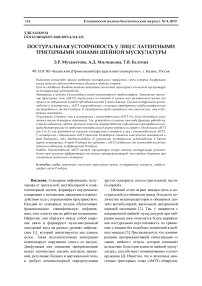Постуральная устойчивость у лиц с латентными триггерными зонами шейной мускулатуры
Автор: Мухаметова Эльвира Ришатовна, Милицкова Ална Дмитриевна, Балтина Татьяна Валерьевна
Журнал: Ульяновский медико-биологический журнал @medbio-ulsu
Рубрика: Физиология
Статья в выпуске: 4, 2019 года.
Бесплатный доступ
Выделяют множество причин развития постуральных нарушений, среди которых дисфункция мышц шейного отдела позвоночника является наиболее спорной. Цель исследования. Выявить влияние латентных миогенных триггерных зон шейной мускулатуры на постуральную устойчивость. Материалы и методы. Использовался метод компьютерной стабилографии. Латентные миогенные триггерные зоны (лМТЗ) определялись по наличию в мышце шеи уплотненного узелка или пучка и по повышенной болевой чувствительности в этой области. Оценка постуральной устойчивости у испытуемых с лМТЗ осуществлялась с помощью стандартного стабилографического тестирования и теста Ромберга. В стандартной пробе оценивались как классические, так и векторные показатели. Результаты. Показано, что у испытуемых с множественными лМТЗ (4 и более) достоверно изменяются только векторные показатели. Так, установлено снижение качества функции равновесия, а также повышение средней линейной скорости центра давления и увеличение нормированной площади векторограммы по сравнению показателями в группе контроля и группе с единичными лМТЗ (от 1 до 3), что указывает на снижение постурального контроля у лиц с множественными лМТЗ...
Латентные миогенные триггерные точки, постуральный контроль, стабилография, тест ромберга
Короткий адрес: https://sciup.org/14116395
IDR: 14116395 | DOI: 10.34014/2227-1848-2019-4-114-123
Список литературы Постуральная устойчивость у лиц с латентными триггерными зонами шейной мускулатуры
- Bronstein A.M. Multisensory integration in balance control. Handb. Clin. Neurol. 2016; 137: 57-66.
- Jones K.D., Horak F.B., Winters-Stone K., Irvine J.M., Bennett R.M. Fibromyalgia is associated with impaired balance and falls. Journal of clinical rheumatology: practical reports on rheumatic & musculoskeletal diseases. 2009; 15 (1): 16-21.
- Hasvold T., Johnsen R. Headache and neck or shoulder pain-frequent and disabling complaints in the general population. Scand. J. Prim. Health Care. 1993; 11 (3): 219-224.
- Hain T.C. Cervicogenic causes of vertigo. Curr. Opin. Neurol. 2015; 28 (1): 69-73.
- Oostendorp R.A.B., van Eupen A.A.J.M., Elvers J.W.H., Bernards J.A. Effects of restrained cervical mobility on involuntary eye movements. J. Man Manip. Ther. 1993; 1 (4): 148-153.
- Reid S.A., Rivett D.A. Manual therapy treatment of cervicogenic dizziness: a systematic review. Man ther. 2005; 10 (1): 4-13.
- Reid S.A., Rivett D.A., Katekar M.G., Callister R. Sustained natural apophyseal glides (SNAGs) are an effective treatment for cervicogenic dizziness. Man Ther. 2008; 13 (4): 357-366.
- Sola A.E., Rodenberger M.L., Gettys B.B. Incidence of hypersensitive areas in posterior shoulder muscles. A survey of two hundred young adults. Am. J. Phys. Med. 1955; 34 (6): 585-590.
- Sciotti V.M., Mittak V.L., DiMarco L., Ford L.M., Plezbert J., Santipadri E., Ball K. Clinical precision of myofascial trigger point location in the trapezius muscle. Pain. 2001; 93 (3): 259-266.
- Wade B. Trigger points in the upper trapezius or normal subtrapezial anatomy? Physiother. Can. 2001; 53 (3): 219-222.
- Chen S.M., Chen J.T., Kuan T.S., Hong T.S., Hong C.Z. Decrease in pressure pain thresholds of latent myofascial trigger points in the middle finger extensors immediately after continuous piano practice. J. Musculoskelet Pain. 2000; 8 (3): 83-92.
- Herdman S.J., Clendaniel R. Vestibular rehabilitation. FA Davis; 2014.
- Ryan G.M.S., Cope S. Cervical vertigo. Lancet. 1955; 266 (6905): 1355-1359.
- Croft P.R., Lewis M., Papageorgiou A.C., Thomas E., Jayson I.M., Macfarlane G.J., Silman A.J. Risk factors for neck pain: a longitudinal study in the general population. pain. 2001; 93 (3): 317-325.
- Scott J., Huskisson E.C. Graphic representation of pain. pain. 1976; 2 (2): 175-184.
- Gerwin R.D., Shannon S., Hong C.Z., Hubbard D., Gevirtz R. Interrater reliability in myofascial trigger point examination. Pain. 1997; 69 (1-2): 65-73.
- Simons D.G. Review of enigmatic MTrPs as a common cause of enigmatic musculoskeletal pain and dysfunction. J. Electromyogr Kinesiol. 2004; 14 (1): 95-107.
- Усачев В.И., Доценко В.И., Кононов А.Ф., Артемов В.Г. Новая методология стабилометрической диагностики нарушения функции равновесия тела. Вестник оториноларингологии. 2009; 3: 19-22.
- Silva A.G., Cruz A.L. Standing balance in patients with whiplash-associated neck pain and idiopathic neck pain when compared with asymptomatic participants: a systematic review. Physiother. Theory Pract. 2013; 29 (1): 1-18.
- Cheng C.H., Chien A., Hsu W.L., Yen L.W., Lin Y.H., Cheng H. Y. Changes of postural control and muscle activation pattern in response to external perturbations after neck flexor fatigue in young subjects with and without chronic neck pain. Gait Posture. 2015; 41 (3): 801-807.
- Matre D., Arendt-Neilsen L., Knardahl S. Effects of localization and intensity of experimental muscle pain on ankle joint proprioception. Eur. J. Pain. 2002; 6 (4): 245-260.
- Sipko T., Kuczynski M. Intensity of chronic pain modifies postural control in low back patients. Eur. J. Pain. 2013; 17 (4): 612-620.
- Vuillerme N., Pinsault N. Experimental neck muscle pain impairs standing balance in humans. Exp. Brain. Res. 2009; 192 (4): 723-729.
- Ruhe A., Fejer R., Walker B. Altered postural sway in patients suffering from non-specific neck pain and whiplash associated disorder-A systematic review of the literature. Chiropr. Man Therap. 2011; 19 (1): 13.
- Mense S., Gerwin R.D. (ed.). Muscle pain: diagnosis and treatment. Springer Science & Business Media; 2010.
- Schikora N., Klunter H., Delank S., Eysel-Gosepath K. Influence of cervical spine stabilization via stiff neck on the postural system in healthy patients: compensation or decompensation of the postural system? Eur. Arch. Otorhinolaryngol. 2010; 267: 1623-1628.
- Pedersen J., Sjolander P., Wenngren B.I., Johansson H. Increased intramuscular concentration of brady-kinin increases the static fusimotordrive to muscle spindles in neck muscles of the cat. Pain. 1997; 70 (1): 83-91.
- Thunberg J., Hellstrom F., Sjolander P., Bergenheim M., Wenngren B., Johansson H. Influences on the fusimotor-muscle spindle system from chemosensitive nerve endings in cervical facet joints in the cat: possible implications for whiplash induced disorders. Pain. 2001; 91 (1-2): 15-22.
- Johansson H., Sjolander P., Djupsjobacka M., Bergenheim M., Pedersen J. Pathophysiological mechanisms behind work-related muscle pain syndromes. Am. J. Ind. Med. 1999; 36 (S1): 104-106.
- Sjolander P., Johansson H., Djupsjobacka M. Spinal and supraspinal effects of activity in ligament afferents. J. Electromyogr Kinesiol. 2002; 12 (3): 167-176.


